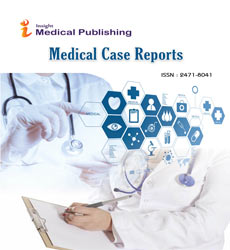A Short Commentary on Cerebrovascular disease
Evandar Henry*
Evandar Henry*
Department of Internal Medicine, Royal Shrewsbury Hospital, UK
- *Corresponding Author:
Received: October 01, 2021; Accepted: October 20, 2021; Published: October 29, 2021
Citation: Henry E (2021) A Short Commentary on Cerebrovascular disease. Med Case Rep Vol.7 No.8.208
Introduction
A stroke or cerebrovascular accident (CVA) is an acute compromise of the cerebral perfusion or vasculature. Approximately 85% of strokes are ischemic and rest are hemorrhagic. In this discussion, we mainly confine to ischemic strokes. Over the past several decades, the incidence of stroke and mortality is decreasing. Stroke is the leading cause of adult disability worldwide. It is thus critical to recognize stroke early and treat it rapidly to prevent or minimize morbidity and mortality. There are many causes of stroke. Hypertension is the leading cause of ischemic stroke. In the younger population, there are numerous causes of stroke including clotting disorders, carotid dissection, and illicit drug abuse. In the acute setting, a quick history and examination to be performed. As "time is brain", it is very important not to waste any time. As acute stroke management is evolving rapidly, one must consider patients for intravenous tissue plasminogen activator (IV tPA) up to 4.5 hours and mechanical thrombectomy for up to 6 hours. The recent DAWN trial showed that one can extend the window for mechanical thrombectomy up to 24 hours in selected cases of large vessel occlusion.
Ischemic etiologies can further be divided into embolic, thrombotic, and lacunar. In general, the common risk factors for stroke include hypertension, diabetes, smoking, obesity, atrial fibrillation, and drug use. Of all the risk factors, hypertension is the most common modifiable risk factor for stroke. Hypertension is most prevalent in African-Americans and also occurs earlier in life. According to JNC8, the recommended blood pressure targets in patients with stroke should be less than 140/90 mm Hg. Chronic uncontrolled hypertension causes small vessel strokes mainly in the internal capsule, thalamus, pons, and cerebellum. Lifestyle measures such as weight loss, salt restriction, taking more fruits and vegetables (such as the Mediterranean diet) are helpful in decreasing the blood pressure. Every 10 mm Hg reduction in blood pressure is associated with a 1/3rd reduction in stroke risk in primary prevention. One-third of the adults in the USA have elevated low-density lipoprotein (LDL), leading to plaque formation in the intracerebral vasculature. Eventually, due to the excessive plaque build-up thrombotic strokes occur. In the older population, the risk of cardioembolic stroke increases mainly due to atrial fibrillation. The rest 20% of strokes are hemorrhagic in nature. Hemorrhagic etiologies can be from hypertension, aneurysm rupture, arteriovenous malformations, venous angiomas, bleeding due to illicit drugs like cocaine, hemorrhagic metastasis, amyloid angiopathy, and other obscure etiologies.
Lacunar strokes contribute up about 20% of all ischemic strokes and result from occlusion of the small penetrating branches of the middle cerebral artery, vertebral or basilar artery or the lenticulostriate vessels. Typical causes of lacunar strokes include microemboli, fibrinoid necrosis secondary to vasculitis or hypertension, amyloid angiopathy, and hyaline arteriosclerosis.
Stroke is the fifth leading cause of death in the US. The incidence of stroke is around 800,000 people annually. Stroke is the leading cause of disability. The incidence of stroke has declined, but the morbidity has increased. Due to longer life expectancy, the lifetime risk of stroke is higher in women. Globally, at least 5 million people die from strokes and millions of others remain disabled.
Acute ischemic stroke patients who meet the criteria for rtPA and do not have any contraindications should receive IV rtPA. Patients who have large vessel occlusions should be evaluated for possible endovascular intervention. All patients suspected of having an acute ischemic stroke should be admitted for a full neurological workup. Neurology consultation should be obtained. The workup of acute ischemic stroke includes a search for a source of thrombus, which includes carotid artery evaluation by ultrasound, CTA, MRA, or conventional angiography. A transthoracic echocardiogram is obtained to ascertain for low ejection fraction, the cardiac source of the clot, or patent foramen ovale. EKG and telemetry are obtained to ascertain for rhythms predisposing to stroke such as atrial fibrillation. Labs such as a fasting lipid panel, and hemoglobin A1C, are obtained to ascertain for modifiable risk factors for stroke. Other labs such as a hypercoagulable panel in young patients or B12 and syphilis testing in selected patients is also obtained. Antiplatelet and statins remain the mainstay of medical management of stroke.
Acknowledgement
None
Conflict of Interest
The author declared that there is no conflict of interest.

Open Access Journals
- Aquaculture & Veterinary Science
- Chemistry & Chemical Sciences
- Clinical Sciences
- Engineering
- General Science
- Genetics & Molecular Biology
- Health Care & Nursing
- Immunology & Microbiology
- Materials Science
- Mathematics & Physics
- Medical Sciences
- Neurology & Psychiatry
- Oncology & Cancer Science
- Pharmaceutical Sciences
